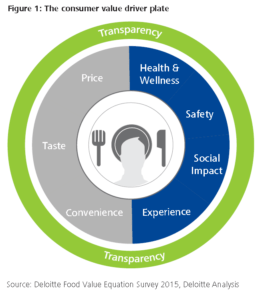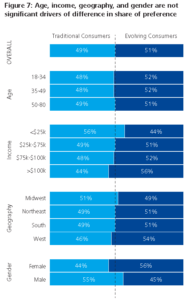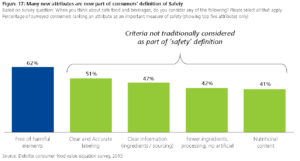A recent report by Deloitte, in collaboration with the Food Marketing Institute (FMI) and the Grocery Manufacturers Associations (GMA), investigates how consumer drivers in the food and beverage industry have evolved over time. Entitled “Capitalizing on the shifting consumer food value equation,” the report explores what kinds of changes have occurred and how retailers and manufacturers should respond. Here are 4 key takeaways:
1. Consumer value drivers have undoubtedly evolved.
In addition to the Traditional drivers of Price, Taste, and Convenience, consumers now also consider “Evolving” drivers such as Health & Wellness, Safety, Social Impact, Experience, and Transparency when making purchases.
As a result, today’s food industry has reached a “New Normal,” wherein companies must reassess their strategy to adapt to this consumer shift. New challenges, as well as new opportunities, abound.
2. The shift in consumer values transcends product categories: it is a shift in consumer mindset, across the board.
Contrary to common perception, this value shift isn’t unique to certain demographics, such as Millennials or high-earning consumers. Although these demographics do consider a greater number of Evolving drivers in their purchasing decisions, all consumer demographics surveyed showed an approximately 50/50 split between those who favor Traditional drivers versus Evolving drivers.
3. Evolving drivers are distinct, but the lines between them have blurred as consumers take a more holistic perspective.
Of the Evolving drivers, Health & Wellness is a top priority for consumers, with 81% of consumers surveyed stating a willingness to pay more for a “healthy” product. In addition, Safety remains important—but today’s consumers view this more holistically, favoring attributes such as “clear labeling” or “limited processing” that blend Safety, Health & Wellness, and Transparency.
Transparency is an overall driver of consumer purchases and often influences where consumers decide to shop. According to Deloitte, “today’s consumers want access to relevant information, when they want it, and in a clear, comprehensive, and understandable way to make informed choices.” Transparency is key for restoring trust, and is top priority for nearly all business executives surveyed.
4. For retailers and manufacturers seeking growth, doing nothing is not an option.
Companies in the food industry need to ask themselves questions to determine how best to adapt to the New Normal. What is the best way to engage consumers to build trust? How do you create products that incorporate multiple Evolving drivers? Do you have the visibility and transparency needed to support brand commitments? These questions represent new challenges—as well as new opportunities—for companies who want to truly engage with shoppers and win back consumer trust.
This new era requires brands to shift their practices to accommodate the changing consumer mindset. This means knowing more about their supply chains—from a product’s components, countries of origin, and supplier and facility locations, to its social and environmental context. Managing these large amounts of data, especially with today’s global supply chains, demands new technology that provides more robust and flexible capabilities.
The Transparency-One platform provides both the power needed to manage global, end-to-end supply chain data, and the agility to monitor complex and constantly changing networks. With the solution, companies can:
- Map their entire supply chains down to the raw material supplier level
- Digitize, manage, and verify supplier data including facility locations and certifications
- Run comprehensive analytics to ensure regulatory compliance
Supply chain transparency is no longer an option for companies; it is a key element for all businesses looking to achieve growth, engage with shoppers, and earn consumer trust.
To download the full report by Deloitte, click here.












